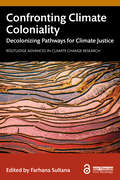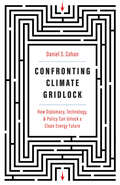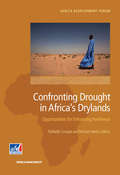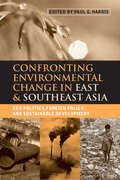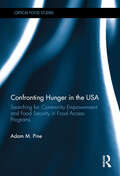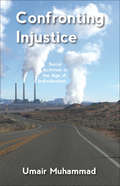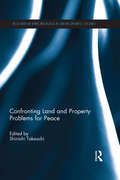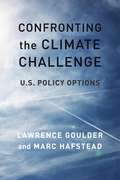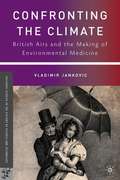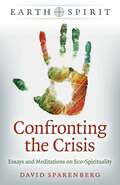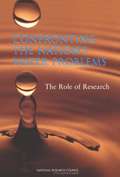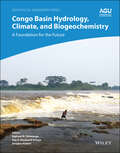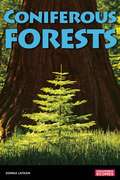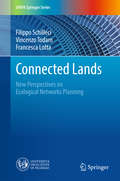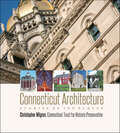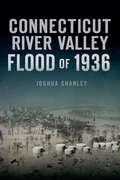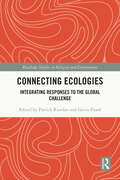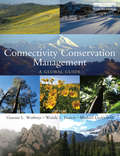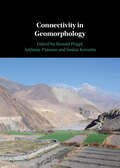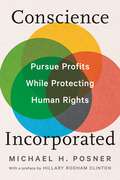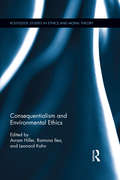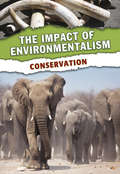- Table View
- List View
Confronting Climate Coloniality: Decolonizing Pathways for Climate Justice (Routledge Advances in Climate Change Research)
by Farhana SultanaThis timely and urgent collection brings together cutting-edge interdisciplinary scholarship and ideas from around the world to present critical examinations of climate coloniality.Confronting Climate Coloniality exposes how legacies of colonialism, imperialism, and capitalism co-produce and exacerbate the climate crisis, create disproportionate impacts on those who contributed the least to climate change, and influence global and local responses. Climate coloniality is perpetuated through processes of neoliberalism, racial capitalism, development interventions, economic growth models, media, and education. Confronting climate coloniality entails decolonizing climate discourses and governance, challenging the dominant framings and policies, interrogating material, geopolitical, and institutional arrangements for tackling the climate crisis, and centering Global South and Indigenous knowledge, experiences, strategies, and solutions. Confronting Climate Coloniality: Decolonizing Pathways for Climate Justice provides critical insights and strategies for transformative action and fosters deeper understandings of the structural injustices entangled with climate change in governance, framings, policies, responses, and praxis. This collection offers pioneering interdisciplinary research on alternative frameworks for decolonized approaches for more meaningful climate justice.With originality, scholarly rigor, and emphasis on amplifying marginalized voices, this collection is an indispensable resource for interdisciplinary scholars, policymakers, and activists committed to advancing climate justice.
Confronting Climate Gridlock: How Diplomacy, Technology, and Policy Can Unlock a Clean Energy Future
by Daniel S CohanAn atmospheric scientist explains why global climate change mitigation and energy decarbonization demand American diplomacy, technology, and policy &“Daniel Cohan makes a compelling case that the problem of climate change is solvable. Fixing the gridlock on global action requires fixing the gridlock here in the United States of America. Cohan shows how that can be done.&”—David Victor, UC San Diego Professor of environmental engineering Daniel Cohan argues that escaping the gravest perils of climate change will first require American diplomacy, technological innovation, and policy to catalyze decarbonization globally. Combining his own expertise along with insights from more than a hundred interviews with diplomats, scholars, and clean-technology pioneers, Cohan identifies flaws in previous efforts to combat climate change. He highlights opportunities for more successful strategies, including international &“climate clubs&” and accelerated development of clean energy technologies. Grounded in history and emerging scholarship, this book offers a forward-looking vision of solutions to confronting climate gridlock and a clear-eyed recognition of the challenges to enacting them.
Confronting Drought in Africa's Drylands: Opportunities for Enhancing Resilience
by Michael Morris Raffaello CervigniDrylands are at the core of Africa's development challenge. Drylands make up about 43 percent of the region's land surface, account for about 75 percent of the area used for agriculture, and are home to about 50 percent of the population, including a disproportionate share of the poor. Due to complex interactions among many factors, vulnerability in drylands is high and rising, jeopardizing the long-term livelihood prospects for hundreds of millions of people. Climate change, which is expected to increase the frequency and severity of extreme weather events, will exacerbate this challenge. African governments and their partners in the international development community stand ready to tackle the challenges confronting drylands, but important questions remain unanswered about how the task should be undertaken. Do dryland environments contain enough resources to generate the food, jobs, and income needed to support sustainable livelihoods for a fast growing population? If not, can injections of external resources make up the deficit? Or is the carrying capacity of drylands so limited that outmigration should be encouraged? Based on analysis of current and projected future drivers of vulnerability and resilience, the report uses an original modeling framework to identify promising interventions, quantify their likely costs and benefits, and describe the policy trade-offs that will need to be addressed. By 2030, economic growth leading to structural change will allow some of the people living in drylands to transition to non-agriculture based livelihood strategies, reducing their vulnerability. Many others will continue to rely on livestock keeping and crop farming. For the latter group, a number of "best bet ? interventions have the potential to make a significant difference in reducing vulnerability and increasing resilience. This report evaluates the opportunities and challenges associated with these interventions, and it draws a number of conclusions that have important implications for policy making.
Confronting Environmental Change in East and Southeast Asia: Eco-politics, Foreign Policy and Sustainable Development
by Paul G Harris'This is clearly a book with great breadth and diversity... a valuable addition to the literature about east and southeast Asia.'T Forsyth, Development Studies Institute London School of Economics and Political Science, in Land Degradation and DevelopmentAs their economies and populations expand, almost all Asian countries are experiencing profound ecological problems at the national, regional and global level; be it air pollution in rapidly growing cities, trans-boundary water pollution or climate change. While the countries of East and Southeast Asia are the victims of environmental change, they are also complicit in causing it at home and abroad. As these countries move towards international environmental cooperation, a central issue becomes the vital connection between foreign policy and environmental problems. Foreign policy is about pursuing and promoting national interests, however it is not always clear what a country's national interests are or ought to be, particularly with regard to complex international ecological issues. On top of this, it is almost always debatable how best to promote them.Confronting Environmental Change in East and Southeast Asia is a collection of concise, hard-hitting essays by a group of international experts and scholars that address these complex issues. The book takes foreign policy considerations into account in its analyses of how states and other actors in East and Southeast Asia confront environmental change through international cooperation and environmentally sustainable development.The first part of the book examines many of the actors, institutions and forces shaping environmental diplomacy and foreign policy in East Asia, with a focus on China and Japan. The second part of the book takes a deeper look at the relationships between ecological politics, international relations and environmentally sustainable development in East and Southeast Asia. Several chapters in the second part focus on how environmental foreign policies impact countries in the region as they endeavour to implement environmentally sustainable development. Together, the analysis and case studies in this volume illuminate how environmental change is confronted - or not - in East and Southeast Asia, with a host of important insights for researchers, governments, policy-makers, conservationists and business people dealing with the profound environmental problems facing the region.
Confronting Hunger in the USA: Searching for Community Empowerment and Food Security in Food Access Programs (Critical Food Studies)
by Adam M. PineFood insecurity in the US is a critical issue that is experienced by approximately 15% of the population each year. Hunger is not caused by an inability to produce enough food for the population, but is instead a manifestation of federal agricultural policies that support the overproduction of commodity crops and neoliberal social policies that seek to lower the amount of benefits dispersed to those in need. This book focuses on how four different food-based community programs address both the physical sensation of hunger as well as the political and economic disempowerment that work against the ability of people experiencing food insecurity to mobilize as a political force. Confronting Hunger in the USA argues that most food programs do more to create community among their volunteers than among program participants and tend to reinforce neoliberal understandings of citizenship. Community food programs reach out to the most vulnerable members of society in caring and gentle ways and often use the language of alternative economies to articulate a different relationship between the individual and the state. However, the projects in this study act as individual pieces of the state's insufficient social safety net and are only beginning to articulate a new relationship between food and society.
Confronting Injustice: Social Activism in the Age of Individualism
by Umair Muhammad“Written by an activist for activists . . . a powerful call for collective action against the social causes of poverty and climate change.” —Climate & CapitalismA new generation of activists working for economic and environmental justice, and against war and poverty, confronts critical questions. Why is the world so unjust and crisis-prone? What kind of world should we fight for? How can we win? In this panoramic yet accessible book, Umair Muhammad engages with these and other urgent debates. He argues that individual solutions like “buying green” are dead ends and that hope for the future lies in a radical expansion of democracy and the transformation of the economy from one based on profit to one that can meet human needs.“A highly recommended read for those who are interested in working together to transform society.” —Chelsey Rhodes, founder of DelusionsofDevelopment.com“This book will force activists to check their intentions. I wasn’t even halfway done before I wanted to share it with everyone I knew.” —Maryama Ahmed, Toronto-based community organizer“A wide-ranging and unflinching look at the global nature of the challenges contemporary activists seek to address. Its blend of environmental and anti-imperialist analysis, grounded in direct organizing experience, makes this a powerful and important resource.” —Dru Oja Jay, coauthor of Paved with Good Intentions“What [Umair] provides is an opening statement in an important discussion that activists must have . . . A must-read book for today’s activists.” —Ian Angus, author of A Redder Shade of Green
Confronting Land and Property Problems for Peace (Routledge Explorations in Development Studies)
by Shinichi TakeuchiThis collection clarifies the background of land and property problems in conflict-affected settings, and explores appropriate policy measures for peace-building. While land and property problems exist in any society, they can be particularly exacerbated in conflict-affected settings – characterized by unstable security, weak governance, loss of proper documentation as well as the return of refugees and Internally Displaced Persons. Unless these problems are properly addressed, they can destabilize fragile political order and hinder economic recovery. Although tackling land and property problems is an important challenge for peace-building, it has been relatively neglected in recent debates about liberal peace-building as a result of the strong focus on state-level institution building, such as security sector reforms and transitional justice. Using rich original data from eight conflict-affected countries, this book examines the topic from the viewpoint of State-society relationship. In contrast to previous literature, this volume analyses land and property problems in conflict-afflicted areas from a long-term perspective of state-building and economic development, rather than concentrating only on the immediate aftermath of the conflict. The long-term perspective enables not only an understanding of the root causes of the property problems in conflict-affected countries, but also elaboration of effective policy measures for peace. Contributors are area specialists and the eight case study countries have been carefully selected for comparative study. The collection applies a common framework to a diverse group of countries – South Sudan, Uganda, Rwanda, Burundi, Cambodia, Timor-Leste, Colombia, and Bosnia-Herzegovina.
Confronting the Climate Challenge: U.S. Policy Options
by Lawrence Goulder Marc HafsteadWithout significant reductions of greenhouse gas emissions, climate change will cause substantial damage to the environment and the economy. The scope of the threat demands a close look at the policies capable of reducing the harm. Confronting the Climate Challenge presents a unique framework for evaluating the impacts of a range of U.S. climate-policy options, both for the economy overall and for particular household groups, industries, and regions. Lawrence Goulder and Marc Hafstead focus on four alternative approaches for reducing carbon dioxide emissions: a revenue-neutral carbon tax, a cap-and-trade program, a clean energy standard, and an increase in the federal gasoline tax. They demonstrate that these policies—if designed correctly—not only can achieve emissions reductions at low cost but also can avoid placing undesirable burdens on low-income household groups or especially vulnerable industries.Goulder and Hafstead apply a multiperiod, economy-wide general equilibrium model that is distinct in its attention to investment dynamics and to interactions between climate policy and the tax system. Exploiting the unique features of the model, they contrast the shorter- and longer-term policy impacts and focus on alternative ways of feeding back—or “recycling”—policy-generated revenues to the private sector. Their work shows how careful policy design, including the judicious use of policy-generated revenues, can achieve desired reductions in carbon dioxide emissions at low cost, avoid uneven impacts across household income groups, and prevent losses of profit in the most vulnerable U.S. industries. The urgency of the climate problem demands comprehensive action, and Confronting the Climate Challenge offers important insights that can help elevate policy discussions and spur needed efforts on the climate front.
Confronting the Climate: British Airs and the Making of Environmental Medicine
by Vladimir JankovićThis book explores the social origins of the Western preoccupation with health and environmental hazards. It looks at the rise of the dichotomy between the vulnerable 'in' and the threatening 'out' by examining the pathologies associated with weather, domestic space, ventilation, clothing, and travel in Britain at the turn of the 19th century.
Confronting the Crisis: Essays and Meditations on Eco-Spirituality
by David SparenbergIf the human species has an evolutionary purpose that purpose is delight. Aren&’t we constituted to experience and express conscious delight in the immensity and intimacy of creation, the diversity, abundance, and miracles of life? We have moved far from such purpose. Instead of imagination&’s dreamers with the Earth, maturing into avatars of relationships, narrators of wonder, we are now a clear and present danger to all species. How do we change identity, direction, and move toward a future inclusive of Earth stability and Human responsibility?
Confronting the Nation's Water Problems: The Role of Research
by Committee on Assessment of Water Resources ResearchIn order to confront the increasingly severe water problems faced by all parts of the country, the United States needs to make a new commitment to research on water resources. A new mechanism is needed to coordinate water research currently fragmented among nearly 20 federal agencies. Given the competition for water among farmers, communities, aquatic ecosystems and other users-as well as emerging challenges such as climate change and the threat of waterborne diseases-Confronting the Nation's Water Problems concludes that an additional $70 million in federal funding should go annually to water research. Funding should go specifically to the areas of water demand and use, water supply augmentation, and other institutional research topics. The book notes that overall federal funding for water research has been stagnant in real terms for the past 30 years and that the portion dedicated to research on water use and social science topics has declined considerably.
Congo Basin Hydrology, Climate, and Biogeochemistry: A Foundation for the Future (Geophysical Monograph Series #269)
by Raphael M. Tshimanga Guy D. Moukandi N’kaya Douglas AlsdorfNew scientific discoveries in the Congo Basin as a result of international collaborations The Congo is the world’s second largest river basin and home to 120 million people. Understanding the cycling of water, sediments, and nutrients is important as the region faces climatic and anthropogenic change. Congo Basin Hydrology, Climate, and Biogeochemistry: A Foundation for the Future explores variations in and influences on rainfall, hydrology and hydraulics, and sediment and carbon dynamics. It features contributions from experts in the region and their international collaborators. Volume highlights include: New in-situ and remotely sensed measurements and model results Use of historic data to assess precipitation and hydrologic changes Exploration of water exchange between wetlands and rivers Biogeochemical processes in the Congo’s forests and wetlands A scientific foundation for hydrologic resource management in the region Studies from different parts of the Congo river and its adjoining basins This book is available in English and French. The American Geophysical Union promotes discovery in Earth and space science for the benefit of humanity. Its publications disseminate scientific knowledge and provide resources for researchers, students, and professionals.
Coniferous Forests
by Donna LathamInvestigating a variety of biomes and today's natural and human threats to their preservation, this interactive series challenges young readers to look at how their own actions influence the planet's health. Four distinct environments are explored in detail, showcasing the assortment of plants and animals that inhabit these outdoor communities as well as how they have adapted to their surroundings. Offering fascinating facts on each ecosystem along with vocabulary-building sidebars, these guides show budding scientists how they can contribute towards ongoing conservation efforts. The diverse woodland of coniferous forests is revealed in this detailed resource, covering topics such as the dangers of deforestation, over hunting, and forest fires, illustrating the rapid decline of this ecosystem's biodiversity.
Connected Lands: New Perspectives on Ecological Networks Planning (UNIPA Springer Series)
by Filippo Schilleci Vincenzo Todaro Francesca LottaThis book explores and outlines the reference theoretical basis of ecological networks within the international debate, focusing on how protected areas should no longer be considered as the sum of different components but rather as a network. The various European, transnational and national models of ecological networks/connections are analyzed on the basis of a detailed, updated study of relevant documents. The complex picture that emerges shows a wide range of reticular-ecological models within European plans and programs, but also many non-integrated experiences. The book subsequently examines the regulation of ecological networks/connections within planning instruments, explaining the critical points and referring to different ecological network models and specific local realities. Lastly, the book addresses two Italian case studies regarding the different normative and planning frameworks, both at a national and regional level, and demonstrating not only how ecological networks/connections can be structured within plans, but also how these networks/connections represent the core element of territory development and preservation. As such, it provides an essential tool for containing habitat fragmentation, offering a new perspective that integrates theoretical approaches and methods with planning models and the lessons learned from local applications.
Connecticut Architecture: Stories of 100 Places (Garnet)
by Christopher WigrenConnecticut boasts some of the oldest and most distinctive architecture in New England, from Colonial churches and Modernist houses to refurbished nineteenth-century factories. The state's history includes landscapes of small farmsteads, country churches, urban streets, tobacco sheds, quiet maritime villages, and town greens, as well as more recent suburbs and corporate headquarters. In his guide to this rich and diverse architectural heritage, Christopher Wigren introduces readers to 100 places across the state. Written for travelers and residents alike, the book features buildings visible from the road.Featuring more than 200 illustrations, the book is organized thematically. Sections include concise entries that treat notable buildings, neighborhoods, and communities, emphasizing the importance of the built environment and its impact on our sense of place. The text highlights key architectural features and trends and relates buildings to the local and regional histories they represent.There are suggestions for further reading and a helpful glossary of architectural termsA project of the Connecticut Trust for Historic Preservation, the book reflects more than 30 years of fieldwork and research in statewide architectural survey and National Register of Historic Places programs.
Connecticut River Valley Flood of 1936 (Disaster)
by Joshua ShanleyIn the beginning of the twentieth century, the Connecticut River Valley was a thriving manufacturing hub for fabric, arms and brass. But early in the spring of 1936, nearly two feet of rain created havoc on a massive scale, killing more than one hundred people and leaving tens of thousands homeless, unemployed and without power for weeks. Patrols were conducted in rowboats on city streets. Typhoid and other public health issues complicated recovery efforts. Adjusted for today's standard, damage estimates exceeded $9 billion, and the flood helped launch FDR's Flood Control Act of 1936. Dams, reservoirs and dikes were constructed to control future flooding. Much of that system now remains in place but has gone largely unmaintained. Author Josh Shanley recounts the greatest flood in New England history and examines the potential for future floods.
Connecting Ecologies: Integrating Responses to the Global Challenge (Routledge Studies in Religion and Environment)
by Gavin Flood Patrick RiordanConnecting Ecologies focuses on the environmental aspects of Pope Francis’ encyclical Laudato Si’ and the challenge to care for our common home. It considers how best to devise and implement the new societal models needed to tackle the ecological problems facing the world today. The book addresses the need for and complexity of an integral ecology, one that looks not only at physical and biological processes but also allows for the contributions of theology, philosophy, spirituality, and psychology, including the implications for the human and social sciences. The contributions document four categories of resonances, resources, requirements, and responses evoked by a reading of Laudato Si’ and include consideration of other faith traditions. They reflect on how care for our common home motivates people in different places, cultures, and professions to cooperate for myriad goods in common. The volume is particularly relevant for scholars working in religious studies and theology with an interest in ecology, the environment, and the Anthropocene.
Connecting the Drops: A Citizens' Guide to Protecting Water Resources
by Karen Schneller-McdonaldThe need for improved water resource protection, beginning with grassroots action, is urgent. The water we use depends on networks of wetlands, streams, and watersheds. Land-use activities, however, are changing these natural systems. Often these changes result in ecological damage, flooding, water pollution, and reduced water supply. We need a healthy environment that sustains our personal and community health; we also need vibrant and sustainable economic development that does not destroy the benefits we derive from nature. Our ability to accomplish both depends on how well we can "connect the drops."In this book, Karen Schneller-McDonald presents the basics of water resource protection: ecology and watershed science; techniques for evaluating environmental impacts; obstacles to protection and how to overcome them; and tips for protection strategies that maximize chances for success. Schneller-McDonald makes clear the important connections among natural cycles, watersheds, and ecosystems; the benefits they provide; and how specific development activities affect water quality and supply.The methods described in Connecting the Drops have broad application in diverse geographic locations. The environmental details may differ, but the methods are the same. For water resource managers and concerned citizens alike, Connecting the Drops helps readers interpret scientific information and contextualize news media reports and industry ads--ultimately offering "how to" guidance for developing resource protection strategies.
Connectivity Conservation Management: A Global Guide
by Michael Lockwood Graeme L. Worboys Wendy L. FrancisIn an era of climate change, deforestation and massive habitat loss, we can no longer rely on parks and protected areas as isolated 'islands of wilderness' to conserve and protect vital biodiversity. Increasing connections are being considered and made between protected areas and 'connectivity' thinking has started to expand to the regional and even the continental scale to match the challenges of conserving biodiversity in the face of global environmental change. This groundbreaking book is the first guide to connectivity conservation management at local, regional and continental scales. Written by leading conservation and protected area management specialists under the auspices of the World Commission on Protected Areas of IUCN, the International Union for the Conservation of Nature, this guide brings together a decade and a half of practice and covers all aspects of connectivity planning and management The book establishes a context for managing connectivity conservation and identifies large scale naturally interconnected areas as critical strategic and adaptive responses to climate change. The second section presents 25 rich and varied case studies from six of the eight biogeographic realms of Earth, including the Cape Floristic Region of Africa, the Maloti-Drakensberg Mountains, the Australian Alps to Atherton Corridor, and the Sacred Himalayan Landscape connectivity area (featuring Mount Everest.) The remarkable 3200 kilometre long Yellowstone to Yukon corridor of Canada and the United States of America is described in detail. The third section introduces a model for managing connectivity areas, shaped by input from IUCN workshops held in 2006 and 2008 and additional research. The final chapter identifies broad guidelines that need to be considered in undertaking connectivity conservation management prior to reinforcing the importance and urgency of this work. This handbook is a must have for all professionals in protected area management, conservation, land management and resource management from the field through senior management and policy. It is also an ideal reference for students and academics in geography, protected area management and from across the environmental and natural sciences, social sciences and landuse planning. Published with Wilburforce Foundation, WWF, ICIMOD, IUCN, WCPA, Australian Alps and The Nature Conservancy.
Connectivity in Geomorphology
by Anthony J. Parsons Ronald E. Pöppl Saskia D. KeesstraThis edited work provides the first comprehensive account of how connectivity concepts and methods are applied in geomorphology. Addressing both qualitative and quantitative aspects, this volume demonstrates how the powerful conceptual framework of connectivity can be used to effectively describe material transfer between geomorphic system components. The book begins by introducing the key elements of connectivity science, drawing from a broad range of disciplines. The latest research on connectivity is then presented for each major process domain, including hillslopes, rivers and glaciers. Methods of quantification and measurement are described, providing an overview of methodologies and indices that can be used to assess connectivity as a property of soils and landscapes, and approaches for modelling connectivity are reviewed. The book concludes with an examination of applications of connectivity thinking in environmental management. Accessible and self-contained, this text is a key resource for practitioners, researchers and graduate students in geomorphology.
Conscience Incorporated: Pursue Profits While Protecting Human Rights
by Michael H. PosnerA guide for business leaders working to create socially conscious, sustainable companies—while pursuing profitsAmid growing international concerns about income inequality, labor abuses, racial injustice, and disinformation online, Conscience Incorporated examines the gaps in current corporate social responsibility measures and what more needs be done to address these challenges. The rise of new technologies such as smartphones and social media have made it easier than ever to document and spread awareness of corporate actions. Despite these developments, large corporations often fail to meaningfully address the human rights abuses linked to their business models and practices. In Conscience Incorporated, Michael Posner addresses what lies at the root of these challenges, drawing on his extensive personal experience as a human rights lawyer, State Department official under President Obama, chair of the Fair Labor Association and Director of the Center for Business and Human Rights at NYU Stern School of Business.Drawing from research into the history of business ethics and anchoring his argument with examples of companies publicly accused of human rights abuses—Nike, Coca-Cola, Walmart, Meta, and more—Posner provides a blueprint for global business leaders to navigate human rights challenges and adopt sustainable corporate practices. Conscience Incorporated highlights the need for increased protections for outsourced workers in faraway nations, greater attention to harmful online content, and prioritization of human rights by investors. He argues that growing public awareness has not been enough to enforce ethical practices for global businesses. As a result, governments, especially in Europe, are becoming more involved in regulating global business practices in various industries.Posner proposes a series of concrete reforms and argues compellingly for why businesses need to devote greater time and resources to protecting basic human rights. Conscience Incorporated is a powerful challenge to the status quo and advocates for a fundamental shift in the principles that govern global businesses.
Conscious Business in Germany: Assessing the Current Situation and Creating an Outlook for a New Paradigm (CSR, Sustainability, Ethics & Governance)
by Nicolas Josef Stahlhofer Christian Schmidkonz Patricia KraftThis book presents conscious business as a constantly expanding and powerful approach to reinvent and shape organizations in a human and beneficial manner. In particular it examines the core characteristics, main drivers and challenges of conscious businesses in Germany. The book offers a structured overview of the current situation of the concept and outlines important issues that need to be considered in order to make independent decisions. Four case studies of successful conscious companies - differing in terms of their size, industry, legal form and international orientation - reveal concrete best practices and provide evidence for the approach's ability to deliver business paradigms that are simultaneously purposeful and profitable.
Consequentialism and Environmental Ethics: Consequentialism And Environmental Ethics (Routledge Studies in Ethics and Moral Theory)
by Ramona Ilea Avram Hiller Leonard KahnThis volume works to connect issues in environmental ethics with the best work in contemporary normative theory. Environmental issues challenge contemporary ethical theorists to account for topics that traditional ethical theories do not address to any significant extent. This book articulates and evaluates consequentialist responses to that challenge. Contributors provide a thorough and well-rounded analysis of the benefits and limitations of the consequentialist perspective in addressing environmental issues. In particular, the contributors use consequentialist theory to address central questions in environmental ethics, such as questions about what kinds of things have value; about decision-making in light of the long-term, intergenerational nature of environmental issues; and about the role that a state’s being natural should play in ethical deliberation.
Conservation
by Clive Hambler Susan M. CanneyThe importance of conservation is growing each year, with increasing concerns over the destruction of biodiversity and the rising awareness of ecosystem services generating new debates on the human-nature relationship. This compact overview integrates the process, theory and practice of conservation for a broad readership, from non-specialists to students and practitioners. Taking a global perspective, it uses examples from around the world to illustrate general themes and show how problems arise from the impact of societal trends on ecological communities. A significant practical component will be particularly valuable for environmental professionals, outlining the requirements for rigorous surveys, biodiversity valuation, the assessment of impact and its mitigation. Thoroughly revised and updated, this second edition reflects trends towards embracing multiple disciplines, considering the links between ecology and the social sciences and bringing conservation to the heart of sustainability and environmental policy.
Conservation (The Impact of Environmentalism)
by Jen GreenWe are all aware of the importance of the environment - it's in the news, it affects our behavior and the decisions we make every day. But what actual impact has environmental thinking had on the world around us? This thought-provoking book looks at the way changing ideas about the environment and sustainability have affected our attitudes to conservation, and will do so in the future.
